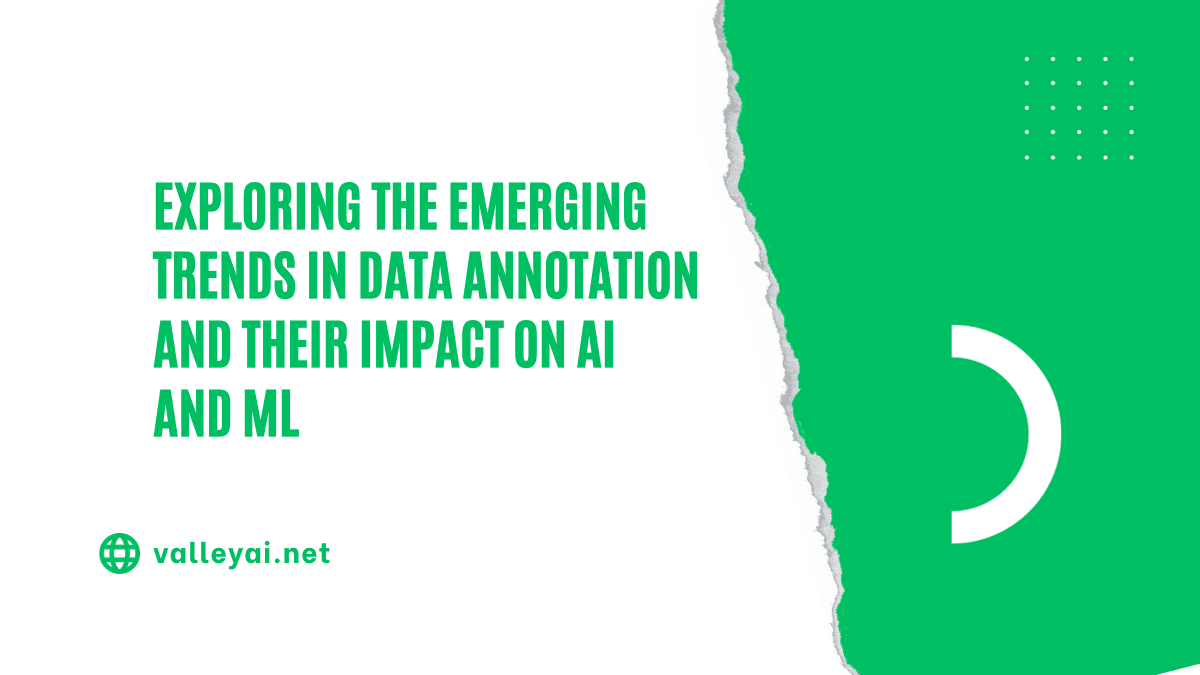Annotating data is crucial to the development of AI and ML systems. As we go more into the complexities of data annotation, it becomes clear that the area is constantly developing, driven by new trends and approaches that have the potential to completely change the fields of AI and ML.
In this article, we begin our trip into the intriguing world of data annotation by tracing its ancestry and conclude with an examination of trends that are changing the field.
The Evolution of Data Annotation
To see where data annotation has come from and where it is going, we need to look at its history. The framework for the modern methods of data annotation was laid by the more conventional approaches. In the past, data points were labeled by hand by human annotators, a laborious and error-prone process.
As AI and ML rose to popularity, however, the shortcomings of these more conventional approaches became clear. Manual annotation fell short of the required scale of labeled data for training complicated models. This motivated the development of semi-supervised learning, where models can acquire knowledge from imperfectly labeled data.
Analysis of the Market for Data Annotation Services
In order for AI and ML models to function properly, high-quality annotation is required. Bad algorithms and incorrect predictions can be the result of inaccurate or inconsistent annotations. As a result, AI data annotation services are not an optional extra on the road to mastery; they are essential.
Image source: Pexels
Consistency and precision in annotations are of the utmost importance. Extensive quality assurance systems, feedback loops, and the integration of human and machine learning tools are required to achieve such lofty goals.
Data Annotation Industry Leaders
Several giants have emerged in the vast data annotation services business, using cutting-edge technology to provide an abundance of annotation options. Because they provide the data upon which AI and ML flourish, these best annotation companies have become indispensable to the field. Here are a few of the more prominent ones: Amazon Mechanical Turk, Scale AI, CloudFactory, Supervisely, and Labelbox.
Main Data Annotation Services
As more and more sectors recognize the value of having their training data annotated, this industry is undergoing rapid development and expansion. Annotating images, texts, videos, and sounds are all important services in this market. Word annotation is concerned with the tagging and categorization of word data, while picture annotation entails naming objects, persons, or regions of interest in photographs.
Objects, activities, and events in video footage can be annotated, while audio can be transcribed and labeled through the process of audio annotation. Annotation services providers frequently use both human and machine annotators to guarantee high quality and efficiency. Businesses in a wide variety of industries are increasingly in need of high-quality labeled data; thus, the data annotation services industry has developed new technologies and processes to satisfy these demands.
Revealing the Future: Data Annotation Developments and Trends
- Automated Annotation Techniques: Integrating AI-powered automation is a game-changer for the future of data annotation and AI projects. Intelligent algorithms are supplementing, and in some cases, replacing traditional hand annotation methods. Machine learning models are increasingly being used to assist human annotators by quickly and accurately identifying patterns, classifying objects, and annotating data.
- Crowdsourcing: Data annotation in the modern era is built on the solid foundation of crowdsourcing. Using crowdsourcing, massive datasets may be annotated rapidly and cheaply. Crowdsourcing platforms unite people from all over the world to share their knowledge and help with everything from image categorization to sentiment analysis.
- Specialized Annotation for Niche Sectors: Medical imaging and driverless vehicles are two examples of specialized industries that necessitate expert annotation. For example, in order to train AI models for illness diagnosis, medical imaging annotation requires precision and subject expertise. Annotating data for autonomous vehicles requires a similar level of comprehension of complicated traffic conditions and pedestrian safety.
- An Improved Annotation Process: AI’s inherent capacity for self-improvement. Researchers in the domains of AI and ML have more to gain from using data annotation services than just a convenient tool.
Implications for the Future of AI and Machine Learning
Better AI and ML are possible with the help of data annotation services. Improved machine learning accuracy is made possible by detailed annotations. From autonomous vehicles navigating congested streets to advanced medical AI systems identifying rare diseases, these models can make educated decisions.
Implications depend heavily on the quality and quantity of collected data. For AI to be truly useful and accessible, it must be trained on data that reflects the diversity of human experience. We need expert data labeling services, especially those tailored to certain industries, if we want AI and ML to be accessible to a wider range of use cases and user groups.
Problems with Modern Data Annotation
Source: Pexels
The progress made in data annotation is tremendous, but it is not without its difficulties. As the scope of data annotation grows, it is essential that privacy and ethics remain top priorities. Companies constantly face pressure to increase productivity without sacrificing quality in order to keep up with the ever-increasing demand for tagged data.
Keeping up with ever-changing requirements is made more difficult by the inherently fluid nature of AI and ML initiatives, and the ever-developing technology landscape necessitates a flexible and dedicated approach.
Conclusion
Data annotation services have a unique place in the evolution of artificial intelligence. Data annotation has come a long way, from manual processes to the incorporation of AI, and from crowdsourcing to specialization. Trusted data annotation providers are an indispensable and dynamic force in the AI industry.
As we navigate this era of innovation, it is essential to remain current on the most recent data annotation trends. By doing so, we not only contribute to the development of AI and ML, but also ensure that these technologies will continue to influence a future in which the possibilities are limited only by our imagination. With its constant evolution, data annotation remains the unsung savior propelling AI to ever-expanding horizons.
- Understanding the Landscape of Cloud Vulnerability Management - March 25, 2024
- Quality Assurance Strategies for Startups: Ensuring Software Reliability - March 5, 2024
- Working of NLP to Improve Copywriting in AI Paraphrasing Tool - February 28, 2024

